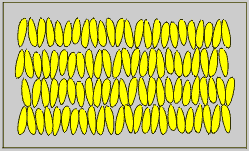Liquid crystal displays (LCDs) are now so common that we take it for granted that people know what we are talking about when we use the phrase.
But how many of us know what liquid crystals are? The term itself seems to be a contradiction. Crystals, such as quartz, are formed when molecules form a three-dimensional matrix by attaching themselves firmly to each other in a regular pattern in which they all point in exactly the same direction. This is why crystals have perfectly flat surfaces. The bond between the molecules of some crystals, such as common salt or sugar, can be broken fairly easily by putting them into water but the result isn’t a liquid crystal, just a solution. So what is a liquid crystal?
The term “liquid crystal” is used to describe a substance which is in a state between a liquid and a crystal but exhibits properties similar to both. Molecules in liquid crystals tend to arrange themselves until they all point in the same general direction but, at the same time, the whole mass can flow like a liquid.
The first person to observe the liquid crystal state was an Austrian botanist called Friedrich Reinitzer. He heated a sample of a material known as cholesteryl benzoate, which changed into a milky fluid as it got hotter. As the temperature increased further, the fluid changed until it became a transparent liquid. The milky fluid that he saw was the liquid crystal state of cholesteryl benzoate.
There are many chemical compounds that can exist in this liquid crystal state. Many of them can be formed by cooling a liquid or heating a solid and these are known as thermotropic liquid crystals, meaning that they change under the influence of temperature. Some will revert to their original state if the process is reversed but for others it’s a one way trip. Other compounds require a solvent to be used to make the state change take place, their molecules linking together into chains under the influence of the solvent. Once the solvent is removed, the molecules retain their new arrangement and a liquid crystal has been created. These are known as lyotropic liquid crystals, because they change under a loosening influence, i.e. the solvent.
There are many different uses for liquid crystals. The following look at those which are used to make displays and how this is achieved:

